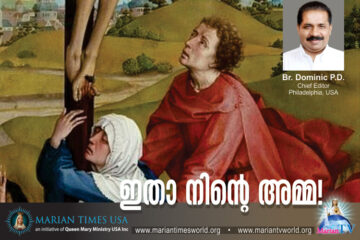Does God desire our thanks? (Sunday Homily)


~ Fr. Abraham Mutholath, Chicago, USA. ~
HOMILY SIXTH SUNDAY OF KAITHA
INTRODUCTION
During the Biblical times, healingof leprosy was considered as a great miracle like raising someone after death or healing a man born blind. When Jesus healed 10 lepers in one instance, it was the manifestation of his Messianic appearance. Only one among the cured 10 lepers showed the willingness to return to Jesus and to express his gratitude and worship towards God. Though Jews despised Samaritans, Jesus praised the grateful Samaritan. His attitude towards Jesus led him to his spiritual salvation which the other nine missed. We are indebted to God and many others in our growth and sustenance. Let us be grateful to them and express that in our life.
The Bible Text
Luke 17:11-19
(11) As he continued his journey to Jerusalem, he traveled through Samaria and Galilee. (12) As he was entering a village, ten lepers met [him]. They stood at a distance from him (13) and raised their voice, saying, “Jesus, Master! Have pity on us!” (14) And when he saw them, he said, “Go show yourselves to the priests.” As they were going they were cleansed. (15) And one of them, realizing he had been healed, returned, glorifying God in a loud voice; (16) and he fell at the feet of Jesus and thanked him. He was a Samaritan. (17) Jesus said in reply, “Ten were cleansed, were they not? Where are the other nine? (18) Has none but this foreigner returned to give thanks to God?” (19) Then he said to him, “Stand up and go; your faith has saved you.”
Interpretation
(11) As he continued his journey to Jerusalem, he traveled through Samaria and Galilee.
Since Jews were not in good terms with Samaritans, the Jews from Galilee used tobypass Samaria when they traveledsouth to Jerusalem. For that, they used to cross River Jordan and travel on the eastern side of the riverand cross back to Jericho to reach Jerusalem. According to Luke’s gospel, Jesus was traveling through Samaria and Galilee that was the border between the two. A mixed group of lepers lived there and met Jesus, seeking his miraculous help. Jesus was on his last trip to Jerusalem for his self-sacrifice there. Some scholars belive that Jesus had escaped from Jewish leaders to that area after raising Lazarus from the dead (John 11:54) because his time for self-sacrifice according to the timeline of his Father had not yet arrived. Then he was returning to Jerusalem to accomplish his redemptive mission.
(12) As he was entering a village, ten lepers met [him]. They stood at a distance from him.
The name of the village is not specified because that village might be insignificant, especially because it was in between the Jewish and Samaritan provinces. Such a village was suitable for the 10 lepers to live, because they were outcasts from Jewish community and had formed as a mixed group of Jews and Samaritans.
Leprosy
Researchers found leprosy bacteria among some mummies in Egypt. Hence it is believed that leprosy was prevalent in the past and Israelites received this disease from Egypt while they were slaves for 400 years there. Leprosy was misunderstood and feared throughout history as incurable and contagious. It was considered as a curse or punishment from God for the sins of the affected people. According to Deuteronomy 28:27 Moses said: “The LORD will afflict you with the boils of Egypt and with tumors, festering sores and the itch, from which you cannot be cured.” Cancer and elephantiasis were also considered as leprosy. The lepers were considered as sinners and spiritually dead. So, they were declared unclean officially by priests after inspection and were expelled as outcasts from their family and society. Leviticus chapter 13 gives details of how the priests should examine the leper and declare him clean or unclean. The public avoided any contact with the lepers who were supposed to cry out “unclean, unclean” and keep a distance from others (Leviticus 13:45-46). The places where lepers entered were considered defiled. Though they could enter in the synagogue for worship, they had an isolated place there. They had to enter together before the congregation entered and leave only after they left.If the lepers go beyond their allowed boundary anywhere, they were punished with forty whip stripes. The first successful multi-drug treatment (MDT) for leprosy was developed only in the 1970s on the island of Malta.
Ten lepers
When lepers were outcast as unclean from their family and society, they were isolated and lost their social and financial status. They had no means for their living. They might even lose their hope in life and faith in God. So, regardless of their past status, all the lepers become equals. Thus, the Jewish and Samaritan lepers became one team of “unclean” or “untouchables” for mutual support. While keeping legal distance from the community, they used to hang around the village as beggars to obtain food or other necessities of life from their sympathetic family members or any kindhearted villagers. A similar union of lepers is found in 2Kings 7:3 where four lepers were at a city gate during the time of Prophet Elisha.
Stood at a distance from him
The lepers kept a distance from Jesus, as prescribed by the rabbis. Usually it was one hundred steps or six feet. The ten lepers kept this distance and Jesus did not approach to touch them. Whereas in Matthew 8:3, Jesus touched a leper and healed him immediately.
(13) and raised their voice, saying, “Jesus, Master! Have pity on us!”
Since the lepers had to keep respectful distance, they had to cry out loud to Jesus for mercy and their unison cry was an expression of their desperate need for help. They addressed Jesus as “Master” used for secular official, teacher, or rabbi. So, they did not know much of Jesus as a prophet or Son of God. The text does not say that they asked for healing, unlike the leper in Matthew 8:1-4 who asked to make him clean. They asked for mercy as what they usually ask from others.
(14) And when he saw them, he said, “Go show yourselves to the priests.” As they were going they were cleansed.
“Go show yourselves to the priests.”
When the lepers asked for mercy without specifying what kind of kindness they wanted, Jesus also gave an indirect reply. He did not say that he would heal them but asked them to go and show themselves to the priests. Plural “priests” is used because one priest could not test all the ten lepers at a time. The test was a time-consuming procedure as described in Leviticus.
An unclean leper was not supposed to approach the priest for inspection. Hence, the lepers understood from the instruction of Jesus that they would be healed before they encounter the priests. They believed what Jesus had told them and obeyed his command.According to the Law of Moses, priests had to confirm the leper’s healing with rituals and sacrifices that took eight days (Leviticus 14: 1-32).
As they were going they were cleansed.
On their way to see the priests, who often lived together in villages of Israel settlement, the lepers realized that they were healed. The cure of a leper was unusual, and rabbi considered it as difficult as raising a deceased person or healing a man born blind. Only two cures of lepers are recorded in the Old Testament. One was the healing of Miriam, the sister of Moses who had leprosy for seven days as a punishment for speaking against the leadership of Moses (Number 12:9-15). The other one was the healing of Naaman, the army commander of the king of Aram, by Elisha the prophet by asking him to wash seven times in the Jordan River (2Kings chapter 5). There was no more healing of lepers in the following 700 years in Israel. So, healing of lepers by Jesus was a sign of messianic manifestation.
(15) And one of them, realizing he had been healed, returned, glorifying God in a loud voice;
When the lepers realized that they were perfectly healed, they might have been excited to experience an unheard miracle, ten times greater than the healing of the one leper in Mathew 8:1-4. But hey could not agree on one thing: Should they return to Jesus to thank and praise God? They were divided as one against nine. Only one among the 10 was convinced that he should return to thank Jesus. He might have realized that Jesus was not just a rabbi, but the Messiah to which the other Jewish lepers might have disagreed. The nine, after getting their certification of acceptance to the community by the priests, went their own ways; may be to share their excitement with their family and community; while ignoring the one who cured them. The one former leper who returned to Jesus could not keep quiet. He was glorifying God in a loud voice because he was convinced that God healed him through His son Jesus.
(16) and he fell at the feet of Jesus and thanked him. He was a Samaritan.
The leper who returned to Jesus expressed his gratitude by falling at the feet of Jesus. That was his expression of his boundless humility and worship before the Son of God. Though he might have heard of the miracles of Jesus, he had a personal experience of it. As a Samaritan, he might have believed that he did not deserve such an outstanding favor from Jesus, a Jewish Rabbi. The other nine might have felt that they deserved such a favor from Jesus because they were Jews. However, they did not feel like returning to the Lord to thank him or give witness of Jesus to others for the favor they had received. They might have even discouraged the healed Samaritan from going back to thank Jesus or worship him.
Luke the Evangelist discloses that the returned former leper was a Samaritan. That has a special relevance for his readers. Though there were barriers between Jews and Samaritans,that should be taken away in Christianity. Jesus favored Samaritans in many instances like the story of the Good Samaritan (Luke 10:25-37), the Samaritan woman at the well (John 4:1-42), and rebuking James and John from calling down fire from heaven to consume Samaritans when they refused to welcome Jesus because he was heading for Jerusalem (Luke 9:53-55). Jesus acknowledged the gratitude of the Samaritan and exposed him as an example for others, including Jews, who underestimated the Samaritans. As in the case of the Good Samaritan, here was another role model from the Samaritans.
(17) Jesus said in reply, “Ten were cleansed, were they not? Where are the other nine?
Once healing took place, the nine Jewish people could not get along with the Samaritan. While they were lepers, the Jewish and Samaritan lepers were downgraded to same low status in the society and they were united to support one another. Their collegiality was lost once they regained their health. So, the nine did not want to walk with the Samaritan to return to Jesus. Jesus did not like their mentality of disengaging the friendship based on religious separationwhen they were cured.
(18) Has none but this foreigner returned to give thanks to God?”
The word foreigner did not mean national difference but one who did not belong to the Jews. Samaritans were aliens for Jews because, being a mixed race, Jews did not consider Samaritans as children of Abraham.
(19) Then he said to him, “Stand up and go; your faith has saved you.”
The Samaritan’s return to Jesus in gratitude and worship of God was an expression of his faith in Jesus. That was the reason Jesus said his faith brought him salvation. While all the ten received physical healing, only the Samaritan got the spiritual healing as well. Sin and guilt feeling were associated with leprosy. Jesus gave the Samaritan a wholistic healing and entrance to the Kingdom of God.
Message
- When we are in sin, we are in spiritual leprosy. Like the 10 lepers who formed a team of lepers, often sinners also form teams to commit sins. We can come out of sinful leprosy only with the power of Jesus. Like the ten lepers, let us cry out to Jesus asking for his mercy.
- Jesus asked the lepers to go to the priests to get certified according to the prescriptions of the law. Their compliance to the direction of Jesus was an expression of their faith in Jesus. Their obedience to the words of Jesus without questioning or doubt saved them from an incurable disease. As Christians, we need to believe and obey Jesus for our spiritual wellbeing.
- When the Samaritan leper received an unusually great favor from Jesus, he felt that he should return to thank Jesus even though his former nine friends might have discouraged him from doing so. When someone who did not deserve a favor receives it, such a person will be more grateful to the one who offered help. Jesus wanted his followers to be kind even to those who do not deserve our mercy.
- Out of the ten cured, only the despised Samaritan had the good will to return to Jesus to express his gratitude and offer his worship to God. He got public acknowledgement from Jesus and salvation besides his physical healing. Let us not underestimate the least persons in the society. Such persons could be greater than us in front of God.
- Jesus openly expressed the need for gratefulness in this event. We are obliged to God for our life and all the good things we enjoy in our life including our spiritual life. It is not only when we get a favor like healing that we need to express our thanks, but also during our good times.
- We are obliged to many people who had guided us, served us, and helped in our upliftment throughout our lives. Are we grateful to them and do we express our gratitude to them?
മരിയന് ടൈംസിലെ ഇന്നത്തെ പ്രധാനപ്പെട്ട അപ്ഡേറ്റുകള് താഴെ ലഭിക്കുന്നതാണ്.









